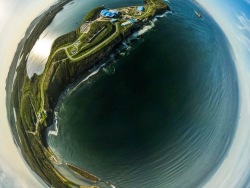June 8: World Ocean Day

June 8 is annually celebrated as World Ocean Day. It is one of the most important days to the Primorsky Aquarium, along with its birthday. It is worth reminding that this year marks the 5th anniversary of the Aquarium’s official opening.
The Primorsky Aquarium turns 5, and there are 5 oceans on Earth as well. In commemoration of World Ocean Day, we are sharing some interesting facts about each of them.
The smallest ocean
The Arctic Ocean is the world’s smallest and shallowest ocean, almost completely covered with ice for the majority of the year. In February, the central parts of the Arctic Ocean are entirely filled with pressure ridges, and a solid ice cover forms on the ocean’s periphery.
The Arctic Ocean is a habitat for the longest marine animal - the lion's mane jellyfish, whose tentacles can grow up to 36 meters in length, and whose bell may be up to 2 meters in diameter.
The largest ocean
The Pacific Ocean occupies almost 30% of our planet’s surface, which is larger than the total area of the continents and islands of the globe. It is also the deepest of the oceans: its maximum depth is almost 11,000 meters. The ocean’s average depth is 4,000 meters.
The Pacific Ocean provides home for hundreds of thousands of animals, some of which are real giants. For instance, the giant Pacific octopus can measure up to 9 meters in length and weigh nearly 200 kg!
The warmest ocean
The Indian Ocean is rather young; its present form took shape “only” 36 million years ago, and most of the ocean’s basin is about 80 million years old.
It is the world’s warmest and saltiest ocean - the upper waters of the northern Indian Ocean warm up to 28° С, or even to 31° С, and the water salinity in some parts of this ocean reaches as high as 40-41‰ due to excess evaporation. By comparison, the average salinities of the Sea of Japan and Black Sea are 34‰ and 18‰, respectively.
Despite of sometimes-extreme conditions, marine life in the Indian Ocean is diverse, and some of its inhabitants, for example, such as the giant grouper, are quite amazing. It is the largest bony fish found on coral reefs that can grow up to 3.5 meters in length and weigh up to 400 kg. Groupers are ambush predators and tend to hide in underwater caves and shipwrecks. Their menu may include small turtles and sharks but they apparently prefer spiny oysters and crabs.
The most studied ocean
Although the Atlantic Ocean is not as large as the Pacific Ocean, every year its width expands by 2-3 cm because of the continental drift, and that of the Pacific consequently shrinks by the same amount.
The Atlantic Ocean receives more river runoff than the Indian and Pacific Oceans combined.
The Atlantic contains a strong ocean current called the Gulf Stream.
The Atlantic Ocean also has the world’s highest tides: in the Bay of Fundy they can reach 18 meters, which is equal to a six-storey building.
New Smyrna Beach, a small town in Florida, holds the nickname "Shark Attack Capital of the World". These predators are so abundant in the local waters that anyone who has swum there has been within, at least, 3 meters of a shark.
The youngest ocean
The Southern Ocean surrounding the Antarctic continent was again added to maps and geography textbooks early in this century: it had formerly been known as the Antarctic Ocean.
The Antarctic is the only continent washed by the Southern Ocean.
One of the main features of this ocean is a large number of icebergs: every year scientists detect more than 200,000 icebergs there.
The list of organisms inhabiting the fifth ocean comprises more than 9,000 marine species, ranging from bacteria to whales.
Penguins are the ultimate symbol of the Antarctic. However, of 18 extant species, only 8 occur on the shores of the Southern Ocean. The others choose to live in a warmer climate but still are dependent on cold currents.